Horsh Ehden
Coordinates: 34°18′29.65″N 35°58′58.91″E / 34.3082361°N 35.9830306°E
| Horsh Ehden Nature Reserve | |
|---|---|
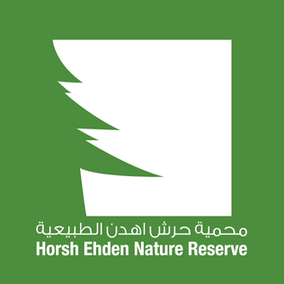 Horsh Ehden Nature Reserve logo | |
| Nearest city | Ehden |
| Established | 9 March 1992[1] |
| Governing body | Horsh Ehden Nature Reserve Committee , Lebanese ministry of the environment |


Horsh Ehden is a Nature Reserve located in North Lebanon, it contains a particularly diverse and beautiful remnant forest of the cedar of Lebanon, making the reserve a very important part of the country’s cultural and natural heritage. Located on the northwestern slopes of Mount Lebanon and pampered by mist and relatively high precipitation, a multitude of rare and endemic plants that flourish in it. Stands of cedars are bordered by a mixed forest of juniper, fir, and the country's last protected community of wild apple trees. On a peaceful hike through the forest, the lucky visitor might spot an endangered eastern imperial eagle or Bonelli's eagle, a gray wolf, a wildcat, a Golden Jackal, or a Red Fox. The reserve's beautiful valleys and gorges, with their wild orchids, brightly colored salamanders, mushrooms, and other flora and fauna, are sure to soothe even the most harried visitor.
Natural history
Biodiversity
Horsh Ehden Nature Reserve is rich in species biodiversity. Over 1,058 plant species have so far been recorded in the reserve, accounting for nearly 40% of all native plant species in Lebanon. This is impressive, considering that the reserve represents less than 0.1% of the total area of Lebanon. The forests form a unique assemblage of conifers, deciduous and evergreen broadleaf trees in an isolated climatic phytoregion with a highly varied topography.
Flora
A total of 1030 species of native plants, and another 39 species of native trees, have been identified in the reserve to date. 70 species use "Lebanon" in their names, such as: Cedrus libani, Salix libani, Berberis libanoticum; and 22 species carry names significant to Lebanon, such as Dianthus karami (after Youssef Bey Karam, a 19th-century national figure), and Astragalus ehdenensis (after the village of Ehden).
The reserve is also considered the southern most limit to Ciliciam fir (Abies cilicica).
Some statistics of the native plant species in the reserve:
- 212 species (20%) are rare and another 126 species (12%) are considered threatened.
- 115 plant species are endemic to Lebanon, and 10 are endemic to Horsh Ehden.
- 78 plant species are recognized as medicinal plants.
Plant communities
The main forest plant communities of highest conservation importance are:
- The Lebanon cedar (Cedrus libani var. libanii) forest community — which represents about 20% of the remaining cedar forests in Lebanon and is thus significant at the national level.
- The Ciliciam fir (Abies cilicica) forest community.
- The Greek juniper (Juniperus excelsa) forest community — which is considered a resource and a gene pool for possible reforestation projects at higher altitude. It is considered nationally significant as a gene stock for the reforestation of the high peaks of Mount Lebanon above 2000 m altitude line.
- The Lebanese wild apple (Malus trilobata) forest community.
Horsh Ehden is the only protected area in Lebanon containing the last remaining forest community of the endemic wild apple of Lebanon.
Fauna
Mammals
More than 27 mammals have been sighted in Horsh Ehden (not including bats), representing a third of Lebanese mammals. There are mainly six big families in the reserve: insectivores, carnivores, rodents, Lagomorpha, Chiroptera, and Artiodactyls.
Thirteen species are globally threatened and on species is locally threatened and highly endangered (the gray wolf, Canis lupus), one species is endemic to Horsh Ehden (the lesser white-toothed shrew, Crocidura suaveolens), and four species are considered threatened at global level.
Among the species recorded are: the Cape hare (Lepus capensis), the wood mouse (Apodemus sylvaticus), the Eurasian badger (Meles meles), the southern white-breasted hedgehog (Erinaceus concolor), the Indian porcupine (Histrix indica), the Caucasian squirrel (Sciurus anomalus), the striped hyena (Hyaena hyanena), the least weasel (Mustela nivalis), the wildcat (Felis silvestris), the gray wolf (Canis lupus), the marbled polecat (Vormela Peregusna).
The reserve may have also been home to many extinct species in Lebanon such as: the roe deer (Capreolus capreolus), the Persian fallow deer (Dama dama mesopotamica), the Anatolian leopard (Panthera pardus tulliana), the Syrian brown bear (Ursus arctos syriacus), and the aurochs (Bos primigenius).
 Caucasian squirrel
Caucasian squirrel Striped hyena
Striped hyena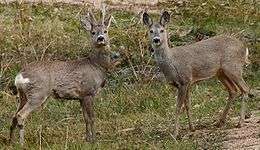 Roe deer (male and female)
Roe deer (male and female) Eurasian badger
Eurasian badger
Birds
Horsh Ehden Nature Reserve is rich in bird life, since it provides a number of different habitats which allows different species to live in it. Among the species recorded 4 species are considered threatened at global level, 5 species are considered vulnerable at regional scale, 18 species are facing unfavourable conditions in Europe, and 57 species are rare in Lebanon.
The species recorded include: eastern imperial eagle (Aquila heliaca), Bonelli's eagle (Hieraaetus fasciatus), blue tit (Parus caeruleus), corn crake (Crex crex), Levant sparrowhawk (Accipiter brevipes), saker falcon (Falco cherrug), white pelican (Pelecanus onocratalus), black stork (Ciconia nigra), Egyptian vulture (Neophron perenopetrus), European bee-eater (Merops apiaster), sand martin (Riparia riparia), white stork (Ciconia ciconia), common wood-pigeon (Columba polumbus), great spotted cuckoo (Clamator glandarius), barn owl (Tyto alba), and the Syrian woodpecker (Dendrocopos syriacus) .
 Song thrush
Song thrush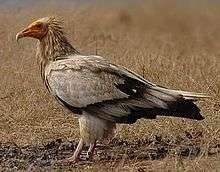 Egyptian vulture
Egyptian vulture Eurasian blue tit
Eurasian blue tit Common wood-pigeon
Common wood-pigeon
Amphibians and reptiles
There are 23 species recorded in Horsh Ehden Nature Reserve, 4 amphibians and 19 reptiles, 1 species is globally threatened (Mediterranean chameleon, Chamaeleo chamaeleon), 1 subspecies is unique, and 19 species are threatened in Lebanon.
The species include: Lebanon viper (Montivipera bornmuelleri), Palestinian viper (Vipera palaestinae), green whip snake (Hierophis viridiflavus), bridled mabuya (Trachylepis vittata), Schreiber's fringe-fingered lizard (Acanthodactylus schreiberi), desert black snake (Walterinnesia aegyptia), common toad (Bufo bufo).
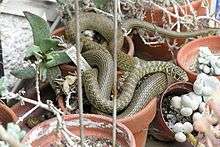 Green whip snake
Green whip snake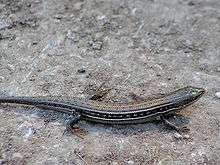 Bridled mabuya
Bridled mabuya Desert black snake
Desert black snake Common toad
Common toad
Cultural heritage and Activities
- Best season to visit: For hikers, autumn and spring are the most temperate and enjoyable seasons for outdoor walks. For visitors who love soaking up nature's many colors, October is the best month to enjoy autumnal colors, and April to May are the best months to see the reserve in bloom.
- Major recreational activities inside the reserve: Bird watching, hiking, mountain biking and photography can be enjoyed throughout the year. The reserve has a camp offering outdoor educational activities for children during the week and for adults on the weekend. The precise activities depend on the season and vary from year-to-year.
 View to ehden from a near mountain
View to ehden from a near mountain Street café in ehden
Street café in ehden - Archaeological sites: There are no archaeological sites inside the reserve. However, in the village of Ehden, the visitor can visit some historical churches and monasteries, as well as the old souk (market place) in the historic part of the city. For example, the Church of St. Mamas (Mar Memas) is considered to be the first Maronite church constructed with stones in Lebanon.
- Major activities nearby the reserve: Visitors may want to spend the night in Ehden or one of the other villages near the reserve. For a panoramic view of north Lebanon, visitors can visit the Cathedral of the Lady of the Citadel (Saydet Al-Hosn), a modern church built in the shape of a star and located on a summit. Visitors will also not want to miss Al-Midan, Ehden’s historic souk characterized by traditional Lebanese architecture and filled with cafés, patisseries, and restaurants.
See also
| Wikimedia Commons has media related to Horsh Ehden Nature Reserve. |
References
- ↑ "Horsh Ehden: About the Reserve". Nature reserve virtual tours. Association of tarvel and tourist agents in Lebanon. Archived from the original on 19 August 2014. Retrieved 10 September 2013.



